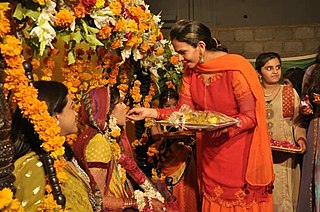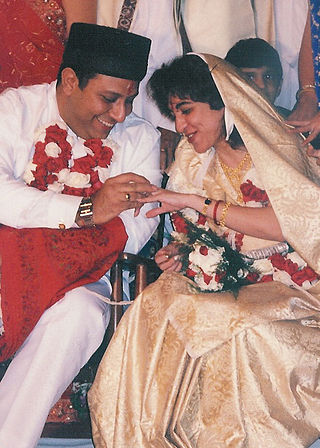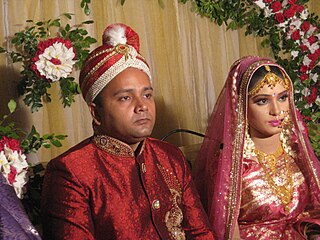This article needs additional citations for verification .(November 2009) |

A vőfély is the Master of Ceremonies before, during and after a traditional wedding in Hungary. He wears a ribboned hat so he can be easily identified.
This article needs additional citations for verification .(November 2009) |

A vőfély is the Master of Ceremonies before, during and after a traditional wedding in Hungary. He wears a ribboned hat so he can be easily identified.
The vőfély is a man (or sometimes these days a woman) who roughly takes the role of the best man, but has many more duties. He is the official host, organizer, coordinator, entertainer and Master of Ceremonies during the wedding. A vőfély can be a relative but more often he is an experienced professional hired by the families.
The vőfély performs many of his roles partly by reciting comic verse which is based on well-known traditional forms but tailored to the individuals being married, and their families.
Traditionally well before the wedding the vőfély helps to arrange the marriage, discusses the details with the families and gets the parents' approvals.
On the day of the wedding the vőfély says goodbye to the parents in the name of the bridegroom at the groom's house and escorts the groom and his family to the bride's house. The vőfély recites comic verse and keeps the guests informed and looks after them to make sure they get enough drinks and food. At the bride's house the vőfély asks for the bride (sometimes the parents pretend that they would not give her away, and the vőfély plays their game by begging or even threatening them, tongue-in-cheek). After the parents "give up" the vőfély says goodbye in the name of the bride.
The vőfély then leads the two united families to the church and to the civil ceremony. [1] The wedding march is often accompanied by a live band playing traditional folk music. The vőfély guides the couple and manages the guests, for example he announces when it is time to congratulate them.
Before the wedding breakfast the vőfély makes a speech then introduces the meals by describing them in comic poems.
During the wedding party the vőfély helps the mood by having the guests play games. While the guests are dancing, the vőfély coordinates the waiters, the photographer, the cameraman and the band in the background to prepare everyone for the next event.
The vőfély recites part of a comic poem before presenting the wedding cake.
At midnight, the vőfély says "the bride is for sale", which means the guests can have a short dance with the bride in exchange for wedding presents or some money (usually in envelopes). The vőfély acts as an auctioneer and helps to "sell" the bride (and sometimes the groom as well). This is the first "collective wealth" they get as a married couple.
The guests may start throwing coins at them and when the "money sweeping" starts, as they grab the coins from the floor, they kick the coins around making them harder to retrieve, thus representing the joint housework and simulating the ups and downs in life. In some regions this tradition is so popular that some guests bring large numbers of coins. No-one is allowed to stop the money sweeping, but the vőfély can help by asking the guests after some time that they can help the pair instead of giving them a hard time.
At midnight the pair leaves the guests for a few minutes, taking their money and presents. They change out of their formal wedding outfits, and return to the dancing. Sometimes the wedding party goes on all night and the remaining guests escort the pair home in the morning.

A wedding is a ceremony where two people are united in marriage. Wedding traditions and customs vary greatly between cultures, ethnic groups, religions, countries, and social classes. Most wedding ceremonies involve an exchange of marriage vows by a couple, presentation of a gift, and a public proclamation of marriage by an authority figure or celebrant. Special wedding garments are often worn, and the ceremony is sometimes followed by a wedding reception. Music, poetry, prayers, or readings from religious texts or literature are also commonly incorporated into the ceremony, as well as superstitious customs.

A wedding reception is a party usually held after the completion of a marriage ceremony as hospitality for those who have attended the wedding, hence the name reception: the couple receive society, in the form of family and friends, for the first time as a married couple. Hosts provide their choice of food and drink, although a wedding cake is popular.

A Jewish wedding is a wedding ceremony that follows Jewish laws and traditions. While wedding ceremonies vary, common features of a Jewish wedding include a ketubah which is signed by two witnesses, a chuppah or huppah, a ring owned by the groom that is given to the bride under the canopy, and the breaking of a glass.
The money dance, dollar dance, or apron dance is an event at some wedding receptions in various cultures. During a money dance, male guests pay to dance briefly with the bride, and sometimes female guests pay to dance with the groom.

The traditional Vietnamese wedding is one of the most important ceremonies in Vietnamese culture, which is influenced by Confucian and Buddhist ideologies.

A Bengali Muslim wedding A true Bengali Muslim wedding includes very few rituals and ceremonies that may span to three days max. In most cases, it starts with the Paka Dekha ceremony. Then, nikkah which is done by a kaji with a fixed denmohor and it ends with the Bou Bhat ceremony that is popular as the wedding reception arranged by the groom's family.
Iranian wedding, also known as Persian wedding, consists of traditions that go back to Zoroastrianism, which was the main religion of pre-Islamic Iran, and although the concepts theories of marriage have been changed by Islamic traditions, the ceremonies have remained more or less the same as they were originally in pre-Islamic Iran. Although modern-day Iran is a multi-ethnic country, Iranian wedding traditions are observed by the majority of ethnic groups in Iran.

Marriage in Pakistan pertains to wedding traditions established and adhered by Pakistani men and women. Despite their local and regional variations, marriages in Pakistan generally follow Islamic marital jurisprudence. Marriages are not only seen as a union between a husband and a wife, but also an alliance between their respective families. These traditions extend to other countries around in the world where Overseas Pakistani communities exist.

Punjabi wedding traditions are a strong reflection of Punjabi culture with ritual, song, dance, food, and dress that have evolved over centuries.

A Zoroastrian wedding is a religious ceremony in Zoroastrianism in which two individuals, a man and a woman, are united. In Zoroastrianism, marriage within the community is encouraged, and is greatly favored in religious texts. The following information will detail ceremony procedures and traditional processes for a Zoroastrian wedding.

A traditional Russian wedding can last between two days and one week. The celebration involves dancing, singing, toasting, and banqueting. The best man and maid of honor are called Witnesses or Свидетели in Russian. The ceremony and the ring exchange take place on the first day of the wedding. Russian weddings are unique matrimonial ceremonies that have undertaken some western traditions, including incorporating bridesmaids into the wedding party.
Ukrainian wedding is the traditional marriage ceremony in Ukrainian culture, both in Ukraine and in the Ukrainian diaspora. The traditional Ukrainian wedding featured a rich assortment of folk music and singing, dancing, and visual art, with rituals dating back to the pre-Christian era. Over time, the ancient pagan traditions and symbols were integrated into Christian ones.
Arabic weddings are ceremonies of matrimony which contain Arab influences or Arabic culture.

Traditional marriage customs in the Philippines and Filipino wedding practices pertain to the characteristics of marriage and wedding traditions established and adhered by them Filipino men and women in the Philippines after a period of adoption courtship and engagement. These traditions extend to other countries around the world where Filipino communities exist. Kasalan is the Filipino word for "wedding", while its root word – kasal – means "marriage". The present-day character of marriages and weddings in the Philippines were primarily influenced by the permutation of Christian, both Catholic and Protestant, Hindu, Islam, Chinese, Spanish, and American models.

Muslim marriage and Islamic wedding customs are traditions and practices that relate to wedding ceremonies and marriage rituals prevailing within the Muslim world. Although Islamic marriage customs and relations vary depending on country of origin and government regulations, both Muslim men and women from around the world are guided by Islamic laws and practices specified in the Quran. Islamic marital jurisprudence allows Muslim men to be married to multiple women.
The Telugu Hindu wedding ceremony is the traditional wedding ceremony of the Telugu people in India. In the 19th century, the ceremony could last up to sixteen days. In modern times, it can last two or more days, depending on the family's financial and social status. The pelli or wedding is considered the strongest of social bonds, and is said to spiritually merge two souls opening the doors to gruhastaashramam. There is a Telugu saying that "Marriage is supposed to be a family union and not an individual formality." However, with changing mindset of the younger generation and due to globalization, marriage these days is being mainly focused solely on the union of the young couple only.

The Azerbaijani wedding tradition is one of the most significant and solemn family traditions of Azerbaijani people. It is multi-stepped, and is related to various compulsory rituals and traditions. Ancient Azerbaijani weddings reflect cycles of traditions, lasting for a long period of time, and need significant material costs.
Weddings in Myanmar, considered auspicious occasions in Burmese culture, reflect various ethnic, religious, and regional traditions. Depending on an individual's family social economic status, personal preferences and titles held, Burmese weddings can be religious or secular, and extravagant or simple. Wedding expenses are covered by the groom's family. Myanmar is a predominantly Buddhist country, and many wedding customs and traditions are influenced by Buddhism.
Sindhi traditions and rituals. Sindhi people have many traditions and rituals starting from the birth of a child to its death. These traditions and rituals differ from region to region and also from one religion to another.